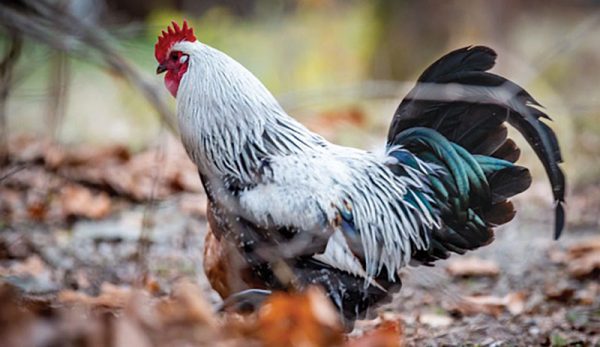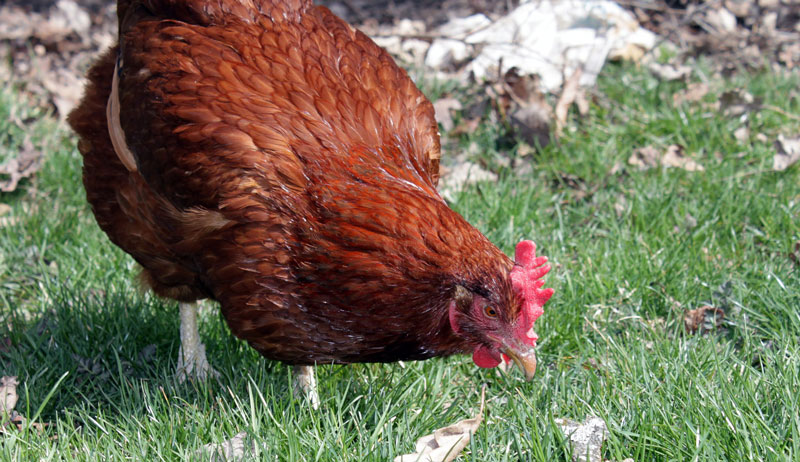
You can find nine chicken breeds named after the state in which they originated. But only three states have a chicken as an official symbol. Rhode Island has the Rhode Island Red, New Hampshire has the New Hampshire chicken and Delaware has the Blue Hen.
Here’s a look at each of the chicken breeds named after their state of origin.
Buckeye
Nettie Metcalf of Warren, Ohio, developed the Buckeye as a dual-purpose farmstead chicken that adapts well to cold weather. It’s the only breed classified as American that has a pea comb, a feature that helps it survive Ohio’s bitter winter weather.
When this breed was developed during the late 1800s, it was originally called Pea Comb Rhode Island Red. But that name did not enhance the breed’s popularity. So, since it originated in the Buckeye State, the breed name was changed to Buckeye.
Buckeye chickens come in large and bantam sizes and a single color: a rich reddish brown of about the same shade as a buckeye nut. The hens lay eggs with brown shells and also brood easily.
Although the buckeye tree is the Ohio’s official state tree, the state bird is the Cardinal. Ohio has no official state chicken. You can find more information on this breed on the website maintained by the American Buckeye Poultry Club.
Read more: Looking for something new? Check out these 20 chicken breeds!
California Gray
The concept of the California Gray originated in the early 1920s in Corvallis, Oregon, where Professor James Dryden at Oregon Agricultural College (now Oregon State University) crossed barred Plymouth Rocks and white Leghorns to develop a superior white-egg layer. Dryden called his hybrid creation the Oregon.
Ironically, crossbreeding was considered to be heresy at that time. The Oregon legislature even debated eliminating the college’s poultry department.
Upon retiring, Dryden moved to Modesto, California, where his son Horace continued a similar breeding program that eventually led to the development of a new breed. Called the California Gray, its introduction to the public came in 1949.
This breed has a single comb, has no bantam counterpart and comes only in a barred pattern that is autosexing (pullets are darker than cockerels). At maturity, a hen’s barring is white and dark gray, a cock’s barring is white and light gray.
The hens lay white-shell eggs and seldom brood.
The California Gray is known for its gentle temperament and outstanding egg production. Now quite rare, this breed is also used primarily to produce California White hybrid layers.
California has no state chicken. The state bird is the California quail.
Delaware
The Delaware breed was developed in the 1940s from silver sports arising from hybrid broilers created by crossing barred Plymouth Rock cocks with New Hampshire hens. George Ellis, owner of the Indian River Hatchery in Ocean View, Delaware, collected some of these sports to breed back to New Hampshire hens.
The resulting hybrids were called Indian Rivers.
At some point, Ellis selected a superior silver sport rooster called Superman to develop a dual-purpose breed called the Delaware, having the sport’s color pattern—white plumage set off by slight barring in the neck, wing and tail feathers. The Delaware has a single comb, comes in a single color pattern and may be large or bantam.
The hens lay brown-shell eggs and make good broodies.
The Delaware state chicken, however, is not the Delaware but rather the unrelated Delaware Blue Hen. You can find more information on the Delaware from the Delaware Poultry Club United.
Delaware Blue Hen
Although not an American Poultry Association-recognized breed, the Blue Hen Chicken is the official state bird of Delaware. It originated with a game hen dating to Colonial days that noted for her steel-blue feathers and the ferocity of her male offspring.
Besides being the official state bird, the Blue Hen is also the official mascot of the University of Delaware. In the 1960s, the university obtained six pairs identified as Delaware Blue Hen Chickens. They were crossed with blue Andalusians, creating a flock that looks more Mediterranean than game.
The original Blue Hen bloodline apparently no longer exists.
Iowa Blue
The Iowa Blue originated in the 1920s with John Logsdon of Decorah, Iowa. The breed’s fame derives from its ability to withstand Iowa’s typical hot, humid summers and cold, dry winters.
By the late 1980s, the last remaining viable flock of Iowa Blues belonged to Ransome Bolson of Decorah, who obtained his starter flock from Logsdon’s wife, Dolly.
From that flock, the Iowa Blue returned from the brink of extinction via the work of a group of enthusiasts. They eventually formed the Iowa Blue Chicken Club, which offers a highly detailed downloadable PDF called History and Characteristics of the Iowa Blue.
The original color of the Iowa Blue is not blue, but rather a pattern called silver penciled. More recently, a birchen variety has also been developed.
Iowa Blues are excellent foragers and good at outsmarting predators. Hens lay eggs with pale brown shells, will brood and make protective mothers. This breed has no bantam counterpart.
The official Iowa state bird is the Eastern Goldfinch. Iowa has no state chicken.
Jersey Giant
Brothers John and Thomas Black of Jobstown, New Jersey, developed the Jersey Giant in the late 1800s as an alternative roaster to the turkey. It’s the heaviest known chicken breed—hens mature to 10 pounds; cocks, 13.

Raising Jersey Giants for meat production turned out to be uneconomical as the chickens take too long to grow. They remain popular for their imposing size, calm disposition and cold-hardiness.
The Jersey Giant has a single comb, may be large or bantam, and comes in a few color varieties, of which black and white are the most common. The hens are good layers of brown-shell eggs and make wonderful broodies, although their eggs may take a day or two longer to hatch than those of other breeds. For more info, visit the National Jersey Giants Club’s website.
New Jersey has no state chicken. The official state bird is the Goldfinch.
New Hampshire
Brothers Oliver, Austin and Leslie Hubbard of Walpole, New Hampshire, created this dual-purpose breed in the early 1900s, through the selective breeding of Rhode Island Reds. They sought to improve the breed’s disease resistance, cold hardiness, rate of growth and degree of muscling for the early broiler industry.
New Hamps have a single comb, may be large or bantam, and come in one color variety—a light reddish bay. The hens lay a decent number of eggs with brown shells and may brood (and when they do, they make great mothers).
This breed is the official state poultry of New Hampshire. The New Hampshire Breeders Club of America maintains a private group on Facebook.
Rhode Island Red
The Rhode Island Red was developed in the late 1800s by various farmers in Massachusetts and Rhode Island as a dual-purpose egg and meat chicken. Some strains have since been bred more for egg production than for meat.

Rhode Island Red hens are among the best layers for a heavy breed, producing large eggs with brown shells. Old-strain hens brood and make good mothers. Hens among the strains developed for increased egg production seldom brood.
The official Rhode Island state bird, this breed has two comb varieties (single and rose), comes in one color (a rich mahogany red with a black tail) and may be large or bantam. The breed is championed by the Rhode Island Red Club of America.
Rhode Island White
J. Alonzo Jocoy of Peacedale, Rhode Island developed the Rhode Island White—unrelated to the Rhode Island Red—in the late 1800s. Jocoy wanted a bird similar in conformation to the Rhode Island Red, but with white plumage for easier plucking.
The standardized Rhode Island White has a rose comb, although occasionally throws chicks with single combs. Production Rhode Island Whites more commonly possess single combs.
Mating Rhode Island Red cocks to Rhode Island White hens results in red sex-link hybrid layers.
You can find the Rhode Island White in large or bantam sizes. Hens lay well, producing brown-shell eggs, and seldom brood.
Although calmer in disposition than the Rhode Island Red, the Rhode Island White never attained the same worldwide popularity.




